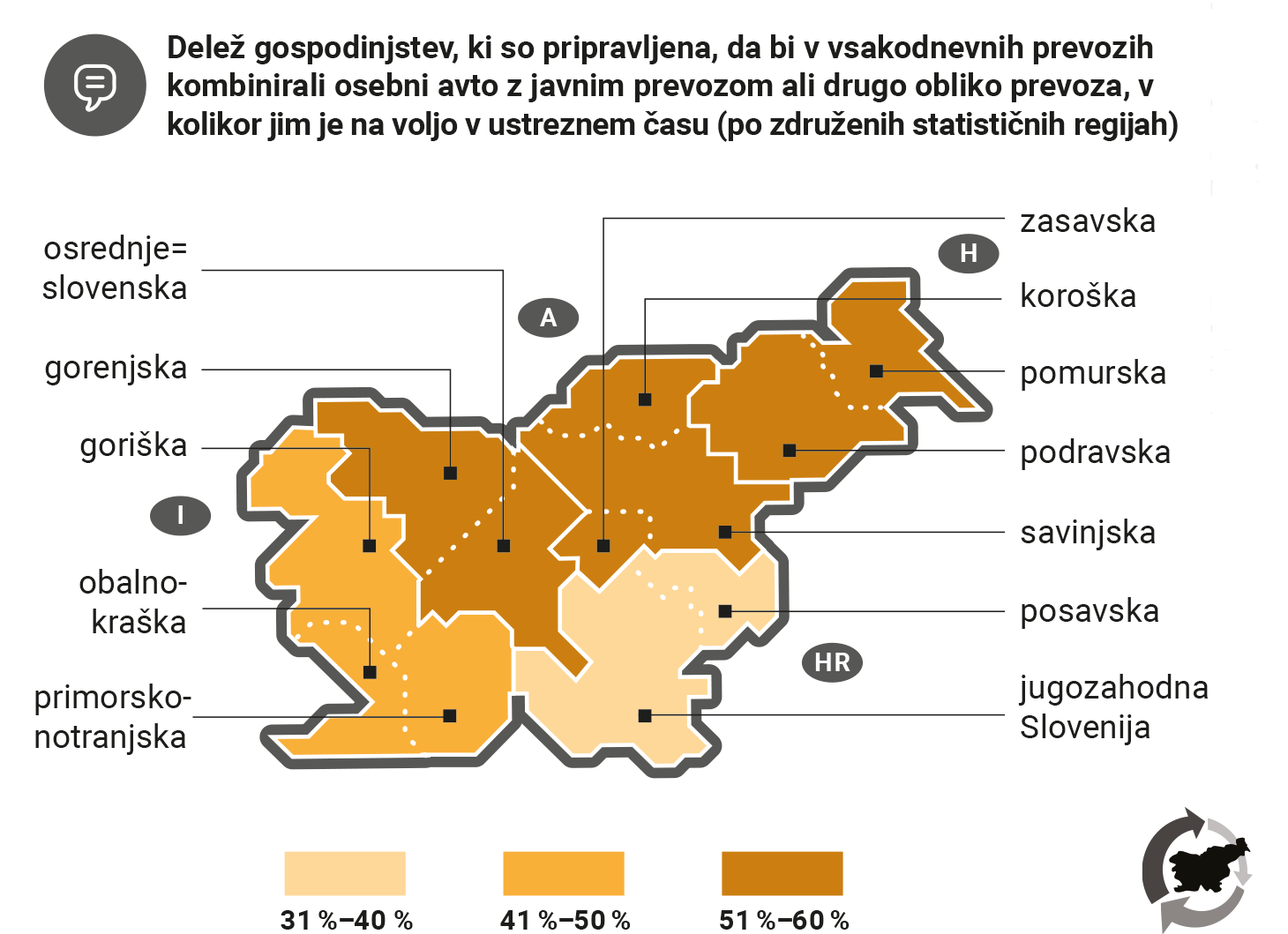[RE04] Public attitude towards sustainable transport

Key message

The car remains the primary mode of transportation, regardless of the distance or purpose of the trip, while the use of public transport does not show a significant increase. The main barriers to using public transport are poor accessibility, inadequate timetables, a lack of connections, and difficult access. Time inefficiency is also a significant issue. However, there are reasons for optimism, as households are increasingly open to using public transport and car-sharing.
Charts
Survey on Energy Efficiency in Slovenia, Informa Echo d.o.o., 2022 (20. 06. 2022)
The analysis of the results must take into account that in 2019 and 2022 the respondents could only choose one option, whereas in past surveys (2010-2017) they could choose several options at a time.
| car (< 5 km)[%] | bicycle (< 5 km)[%] | walking (< 5 km)[%] | public passanger transport (< 5 km)[%] | other forms of transport (< 5 km)[%] | car (5-150 km)[%] | bicycle (5-150 km)[%] | walking (5-150 km)[%] | public passanger transport (5-150 km)[%] | other forms of transport (5-150 km)[%] | |
|---|---|---|---|---|---|---|---|---|---|---|
| 2019 | 55 | 17 | 9 | 7 | 4 | 84 | 2 | 1 | 7 | 6 |
| 2022 | 58 | 13 | 9 | 8 | 8 | 82 | 1 | 1 | 8 | 4 |
Survey on Energy Efficiency in Slovenia, Informa Echo d.o.o. (2018)
When analyzing the results, we need to consider that in 2019, respondents could only choose one mode of transportation, while in previous measurements (2010-2017), and they could select multiple options simultaneously.
| car[%] | walking[%] | bicycle[%] | public passanger transport[%] | |
|---|---|---|---|---|
| 2017 (in summer) | 79 | 33 | 30 | 28 |
| 2017 (in winter) | 80 | 25 | 7 | 26 |
Survey on Energy Efficiency in Slovenia, Informa Echo d.o.o., 2022 (20. 06. 2022)
The analysis of the results must take into account that in 2019 and 2022 the respondents could only choose one option, whereas in past surveys (2010-2017) they could choose several options at a time.
| car[%] | bicycle[%] | walking[%] | public passanger transport[%] | |
|---|---|---|---|---|
| 2010 | 87 | 6 | 7 | 17 |
| 2011 | 87 | 11 | 13 | 21 |
| 2012 | 86 | 7 | 8 | 20 |
| 2015 | 87 | 15 | 14 | 30 |
| 2017 | 92 | 24 | 22 | 23 |
| 2019 | 87 | 1 | 1 | 6 |
| 2022 | 84 | 2 | 1 | 8 |
Survey on Energy Efficiency in Slovenia, Informa Echo d.o.o., 2022 (20. 06. 2022)
| unsuitable timetables[%] | takes too long[%] | poor bus connections[%] | luggage (easier with car)[%] | bus not available at our location[%] | the nearest bus stop is too far away[%] | public transport is not as efficient as abroad and often not on time[%] | I need the car for my job[%] | the bus costs more/too much[%] | out of habit[%] | we use it occasionally[%] | |
|---|---|---|---|---|---|---|---|---|---|---|---|
| 2019 | 33 | 32 | 37 | 24 | 19 | 12 | 15 | 11 | 11 | 10 | 11 |
| 2022 | 32 | 31 | 29 | 20 | 19 | 14 | 14 | 9 | 7 | 7 | 5 |
Survey on Energy Efficiency in Slovenia, Informa Echo d.o.o., 2022 (20. 06. 2022)
| good connections[%] | so we do not use significantly more time compared to car travel[%] | access to connections[%] | cheaper public transport[%] | to contribute to a cleaner environment[%] | to not reduce the level of comfort[%] | other[%] | I don't know[%] | |
|---|---|---|---|---|---|---|---|---|
| 2019 | 43 | 45 | 32 | 32 | 20 | 17 | 4 | 19 |
| 2022 | 42 | 38 | 28 | 26 | 15 | 13 | 4 | 21 |
Survey on Energy Efficiency in Slovenia, Informa Echo d.o.o., 2022 (20. 06. 2022)
| walking [%] | public passanger transport [%] | bicycle [%] | car sharing [%] | other [%] | |
|---|---|---|---|---|---|
| 2011 | 34 | 14 | 16 | 3 | |
| 2012 | 24 | 5 | 13 | 2 | |
| 2015 | 34 | 12 | 20 | 5 | |
| 2017 | 30 | 8 | 19 | 3 | |
| 2019 | 21 | 12 | 15 | 6 | |
| 2022 | 21 | 16 | 15 | 7 | 9 |
Survey on Energy Efficiency in Slovenia, Informa Echo d.o.o., 2022 (20. 06. 2022)
Due to the small sample size the information for specific regions have been merged and are separated by a dotted line.
| 2019 | 2022 | |
| pomurska, podravska | 62 (N=216) | 53 (N=216) |
| koroška, savinjska, zasavska | 73 (N=187) | 60 (N=186) |
| posavska, jugovzhodna Slovenija | 62 (N=104) | 39 (N=106) |
| osrednjeslovenska, gorenjska | 72 (N=358) | 53 (N=365) |
| primorsko-notranjska, obalno-kraška, goriška | 68 (N=137) | 41 (N=139) |









